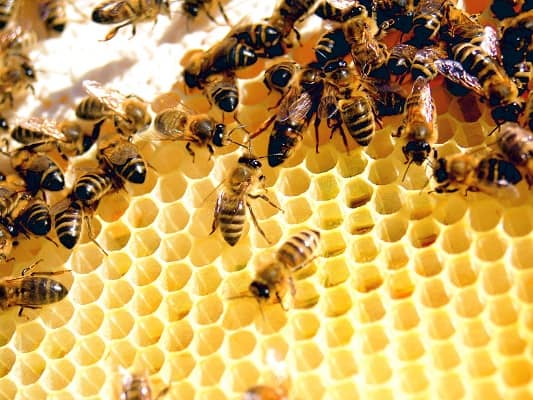
 A recent study finds that giving bees light therapy may help them overcome toxic exposure to pesticides.
A recent study finds that giving bees light therapy may help them overcome toxic exposure to pesticides.
Researchers with the University College London treated four groups of bees from commercial hives with neonicotinoid pesticides, which studies have shown are playing a role in the decline of bee populations worldwide, and gave half of the bees daily doses of near infrared (deep red) light therapy. After ten days, the bees who received light therapy were found to have significantly greater mobility and survival rates compared to the bees who were exposed to the toxins alone, whose mobility and survival dropped off rapidly.
Exposure to neonicotinoids has been found to negatively impact mitochondrial functioning in bees and hamper the production of adenosine triphosphate (ATP), described as the energy transport system for metabolism within cells. Disruption of ATP production can lead to a decrease in energy and mobility, which results in bees who are less likely to feed and groom themselves, often leading to starvation. But the new study shows that near infrared light can combat the process and help improve mitochondrial functioning, a result which researchers say is promising regarding efforts to improve overall bee health.
“Long-wavelength light treatments have been shown in other studies to reduce mitochondrial degeneration which results from aging processes,” said professor Glen Jeffery of the University College London’s Institute for Ophthalmology and co-author of the new study, published in the journal Plos One. “It’s beneficial even for bees that aren’t affected by pesticides, so light therapy can be an effective means of preventing loss of life in case a colony becomes exposed to neonicotinoids. It’s win-win,” says Jeffery.
Earlier studies showed that daily exposure to near infrared light had positive effects on drosophila (fruit flies), reducing disease-based and age-related inflammation, but this is the first study to confirm similar results with bees.
The research team sees the near infrared light therapy, which operates beyond the bee’s visual range and does not affect their behaviour, as potentially serving not only as a preventative measure for bees but also as responsive treatment to a one-off chemical exposure.
“We found that by shining deep red light on the bee which had been affected by the toxic pesticides that they could recover, as it improved mitochondrial and visual function, and enabled them to move around and feed again,” says Dr Michael Powner of the University College London and lead author of the study.
In October, the United States Fish and Wildlife Service for the first time placed seven species of bees on the Endangered Species List, all of them yellow-faced bees native to Hawaii. The move grants the insects federal protection and is likely to put further focus on the plight of bees worldwide. “Listing these species as endangered will certainly help draw attention to the threats that have brought them close to extinction and it also allows us to begin the process of bringing about recovery,” Fish and Wildlife spokesman Brent Lawrence said.
In Canada, there are six bee species said to be critically at risk, according to environmental organization Friends of the Earth, which is urging the federal government to add more species to the list, including the Macropis Cuckoo Bee, the Western Bumble Bee and the Yellow-Banded Bumble Bee.
Leave a Reply
You must be logged in to post a comment.



 Share
Share Tweet
Tweet Share
Share




Comment